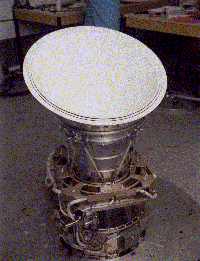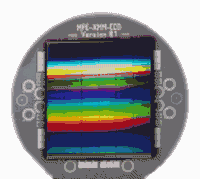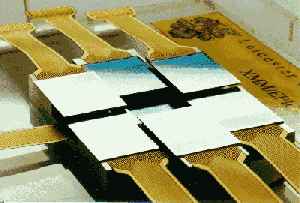


IMAGE - One of the European Photon Imaging Cameras (EPIC)
EPIC is the CCD camera system which will be used to collect images from the XMM spacecraft. The system includes two separate designs (one p-n and two MOS), which will be positioned in the focal plane of each of XMM's three X-ray telescopes.

The p-n Camera shown above is an X-ray Charge Coupled Device (CCD) which comprises an array of 6x2 separate devices, each device having 64x200 pixels. The devices are arranged on a single wafer so as to give a square field of view. The p-n camera will be used with one of the three telescopes.

The other two telescopes will both use MOS
cameras- another new design currently being developed by a consortium
including the University of Birmingham. This CCD camera consists of an
array of 7 chips, each of 600x600 pixels. As with the p-n devices,
these chips are arranged around the telescope axis to give the total
field of view but the central one is set back because the telescope's
focal surface is slightly curved.
All these detectors respond to high energy
particles in the earths radiation belts and in cosmic rays, as well as
to x-ray photons. However, the particles produce tracks which can be
recognised when processing the data on the ground, and thus
eliminated.
To find out more about EPIC externally, click here and follow the links to
instrumentation.

